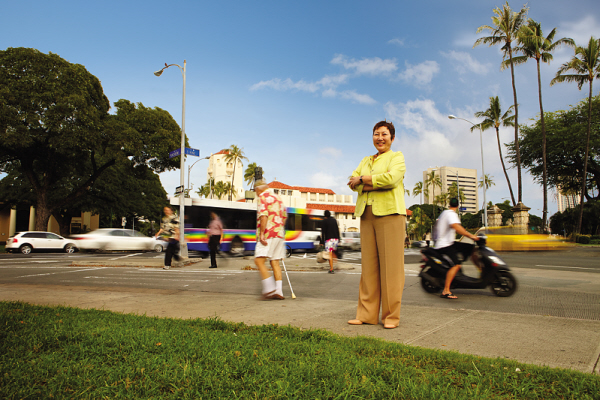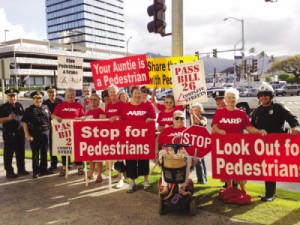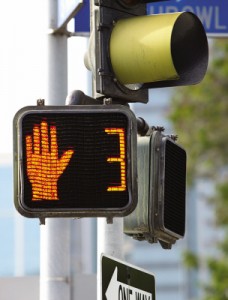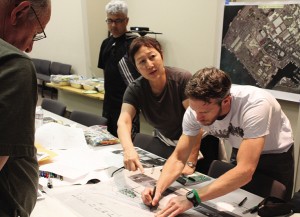
— Stanton
In a split second your life can change dramatically,” says Barbara Kim Stanton, AARP Hawai‘i state director, of a lifethreatening pedestrian crash in 2003. The accident left her with multiple fractures, requiring extensive rehabilitation and a six-month recovery at home. The debilitating incident provided her with unique insight into what it must be like for seniors who have limited mobility and/or depend on home care — as she did for nearly half a year. Ultimately, the experience shaped her view of some of the significant challenges facing our aging community and continued to affect her in 2005 as she assumed leadership of AARP, the influential member organization for people 50-plus.
In this issue, Stanton sits down to talk with Generations about the social changes seniors are facing today — from redefining retirement to the national and local movement toward creating walkable and safe age-friendly communities.
GM: In what ways did the pedestrian crash influence your view of aging?
BKS: The injuries I had were so severe it was like being fast-forwarded into old age. I couldn’t do anything for myself. I couldn’t dress or feed myself. I couldn’t even brush my own teeth. When something like this happens you learn very quickly what life is like for frail, elderly residents who are dependent on friends and family for their basic needs. You start looking at your surroundings and reassessing your ability to age in the home you’re in. It wasn’t long before I realized that the ‘Aiea home, which my husband and I built in 1982, was inadequate for growing old in. It’s a single-level home on a level lot with extra-wide doors that make it easy to navigate from the yard into the house. Still, many of the things I had taken for granted — door handles, window latches, access to the bathroom — took on a new significance because I didn’t have the strength to perform even simple tasks.
Memories of this experience shaped my belief that everyone needs to plan for how to best meet their needs when they can no longer live without the help of others.
GM: What is it like to not be able to take care of basic daily tasks — dressing, eating, personal grooming — that most of us take for granted?

BKS: I was discharged from the hospital after about three weeks and needed around-the-clock assistance for half a year, and several months of rehabilitation services before I was able to return to work. I needed total care. My husband helped me in the morning before he went to work. During the day, I had a physical therapist, an occupational therapist and a nurse. In the afternoon when the last medical person left, my neighbors came in. They took shifts. Fortunately, I had a network of family and friends to cook meals and help in any way they could. Even Mainland friends from college used their vacation to fly over and lend a hand. I’m indebted to a lot of people for helping me recover at home.
Through this experience I learned how unpaid caregivers are the backbone of Hawai‘i’s longterm care system. They are the ones who make it possible for the elders they love to age at home, which is where most Hawai‘i residents say they want to be rather than an expensive care facility.
Of course, the main difference between my situation and the seniors who I met at the rehabilitation hospital was that I eventually started to recover. I was getting better, while the frail, elderly folks I got to know said it was a “good day” if their condition stayed the same.
GM: How important are family caregivers to helping elders with activities of daily life?
BKS: In Hawai‘i today most of the day-to-day care for the elderly is provided by family members, often women, who juggle this responsibility with their jobs. This isn’t talked about much and is rarely viewed as a public issue. That’s beginning to change, especially as the percentage of elderly residents needing home care grows. Hawai‘I residents are beginning to realize that caregiving affects just about everyone. At some point in your life, you will either be a caregiver or you’ll need a caregiver — maybe both.

I’ve experienced both sides of the caregiver experience, and it’s given me valuable perspective. I, along with other family members, cared for both of my parents at their home in Honolulu. I used to stay with them while my husband watched over the kids at our place. After Mom passed, Dad moved in with us for about a year until he went into hospice. Many adult couples with children are juggling similar situations.
AARP research indicates that there are 247,000 family caregivers in Hawai‘i throughout the year, and the value of the unpaid care they provide to loved ones is estimated at $2 billion a year. However, trends show that the number of potential caregivers (aged 45 to 64 for every person aged 80 and older in Hawai‘i) is declining rapidly. In 2010 there were about six potential caregivers available for every older person. By 2030 there will be fewer than three caregivers available. That’s a red flag. Family support is one of the keys to being able to stay in your home and community as you age.
GM: In what ways do family caregivers contribute to keeping health care costs in check?
BKS: The range of services family caregivers provide is very broad. Many take care of all of the basic daily needs such as personal care, bathing, dressing and cooking. Increasingly, they’re also being called on to perform medical tasks that would make a first-year nursing student tremble — such as wound care and tube feedings — often without adequate training.
Caregivers also play a critical role as unofficial “care coordinators” when family members transition from a health facility back to the home. In that respect they’re on the front lines of keeping their loved ones out of costly institutions and preventing readmissions to the hospital. At the State Legislature this year, AARP Hawaii is supporting legislation that will help caregivers in their role as care coordinators. The CARE Act (SB2264) requires hospitals to provide caregivers with instruction on how to provide the care that’s needed when their loved ones return home.
GM: What steps can people take to increase their chances of staying in their homes as they age?
BKS: The most important thing family members can do is talk with each other about the kind of care they want in the future. For adult children watching their parents grow older, it’s normal to feel anxious. But “The Conversation,” as we call it, has to occur — and better sooner than later. The worst thing to do is to wait until a catastrophic health incident occurs in the family. Then you’re scrambling for answers under stress.
We recommend that people become familiar with public and private health care services available in our communities. A good place to start is the office of aging in each of the counties. They have case workers who can sit down and discuss your family’s needs.
Families may also qualify to receive in-home services through Kupuna Care, a state-funded program that offers a safety net for residents who don’t qualify for Medicaid and can’t afford to pay for services.
The state also provides information about caregiving and long-term care options on its Aging and Disability Resources Center website. It’s a one-stop shop for information about what services are available and how much they cost.
GM: Are Hawai‘i residents prepared to cope with the rising cost of long-term care?
BKS: The cost of long-term care in Hawai‘i is among the highest in the country, and few of us are prepared. The median cost of private nursing home care in Hawai‘i is about $145,000 for just one year, and the average stay is about three years. Unless you have private long-term care insurance or make other financing arrangements, that’s an out-of-pocket expense that not many people can afford. Only about 12 percent of residents age 40 and older are covered by private long-term care insurance.
People are generally uninformed about their options when it comes to planning and paying for care, and a tremendous amount of misinformation exists about what programs such as Medicare pay for. We surveyed our members a few years ago and found that 29 percent believe that Medicare covers the cost of long-term care. Actually, it’s Medicaid that pays for the bulk of long-term care in the U.S., but only for the very poor.
GM: What is AARP doing to help raise awareness of the public’s need to plan for their long-term care?
BKS: AARP helped establish the Hawai‘i Long-Term Care Commission, which studied the state’s long-term care system and recommended reforms (click to see Generations, March 2011). One of the Commission’s top proposals to the Legislature was for the state to launch an education and awareness campaign to help Hawai‘i residents understand long-term care and available options to pay for it.
The idea is to help people live independently at home for as long as possible rather than moving to more costly nursing homes. AARP is working with legislators this session to get $500,000 appropriated for this purpose.
Another recommendation was for the state to consider a public, long-term care insurance program for our working population. We are waiting for the results of a financial and actuarial study, due this summer. Depending on what the report finds, legislation establishing the financing program could be introduced as early as 2015.
GM: As you look at the physical layout of our communities, do you think we’re prepared for the aging boom that’s already begun?
BKS: Our communities have been designed with the automobile in mind, which doesn’t support the ability of older residents to age in place. When large numbers of people and cars come together in urbanized areas built primarily for automobiles, the results can be tragic. There have been unacceptably high numbers of pedestrian crashes in Honolulu over the past decade, and the threat to public safety will rise as the percentage of residents age 65 and older increases to 20 percent over the next two decades.
 AARP is working to develop more livable communities where people of all ages and physical abilities have multiple transit options to get safely where they want to go — whether driving, walking, cycling or taking public transportation. What’s really exciting is the new Age-Friendly Cities initiative just announced with the City and County of Honolulu that will transform Honolulu into a place that is livable for everyone — kupuna to keiki.
AARP is working to develop more livable communities where people of all ages and physical abilities have multiple transit options to get safely where they want to go — whether driving, walking, cycling or taking public transportation. What’s really exciting is the new Age-Friendly Cities initiative just announced with the City and County of Honolulu that will transform Honolulu into a place that is livable for everyone — kupuna to keiki.
GM: Can you share some details of the Age-Friendly Cities initiative?
BKS: Mayor Kirk Caldwell announced his commitment to prepare Honolulu to be more age friendly and has partnered with the AARP Network of Livable Cities and the World Health Organization’s Global Network of Age-Friendly Cities and Communities. The WHO Network is part of an international effort to get cities and towns around the world prepared for rapid population aging and increased urbanization.

Over the next five years Honolulu city officials will work with AARP and residents of all ages to improve physical and social environments on O‘ahu that will help older residents remain healthy, active and engaged. This will be a local, community-driven initiative to transform our island into a livable community that’s safe and secure, including affordable housing and adequate transportation. Once in place, these resources will enhance personal independence, allow residents to age in place and foster engagement in civic, economic and social life.
In April a citizens advisory committee will be convened. This group is responsible for developing an action plan that will promote public safety and provide seamless access to shopping, recreational sites, housing and transportation services.
GM: What are your members saying they want to do with their retirement years?
BKS: The Baby Boomers are rewriting traditional definitions of what it means to retire. The first of the Boomers reached age 65 in 2011 and more of them are taking advantage of the extra longevity years their parents and grandparents didn’t have. Regardless of income and whether or not they continue working, they’re reflecting on the meaning and purpose of their lives, overcoming fears, achieving aspirations and building a greater sense of community. Boomers are creating this new life phase and rejecting the notion that their possibilities are shrinking as they get older. They’re using their years of experience not to wind down but to reach even higher.
GM: Are you optimistic about the next 20 years as the boomers move into their 80s and beyond?
BKS: Older adults today are living in a new age of possibilities. For those who prepare for the future, it will be good. Hawai‘i is a great community, we respect our kupuna, and our people know how to pull together. But the challenges with health care are formidable. That’s why I’m concerned about people who may not have enough resources.
My goal with AARP is to help seniors stay connected to their communities and enhance the quality of their lives as they get older.
About AARP Hawaii
AARP is a membership organization for people age 50 and older, with nearly 150,000 members in Hawai‘i. We champion access to affordable, quality health care and deliver a strong message to our elected officials: No cuts to Medicare or Social Security benefits.
We also provide the tools needed to save for retirement, and serve as a reliable information source on critical issues that help older Americans navigate the “what’s next” in their lives.
Drive to End Hunger. Life Reimagined. Financial Freedom Campaign. Fraud Watch Network. Driver Safety.
Tax-Aide. Life@50+ Expo. Consumer Advocacy. Volunteering.
Toll-Free: 1-866-295-7282
Website: www.aarp.org/hi | Facebook: /AARPHawaii | Twitter: @AARPHawaii
Published with the assistance of Bruce Bottorff, director of communications of AARP Hawaii.


Leave a Reply